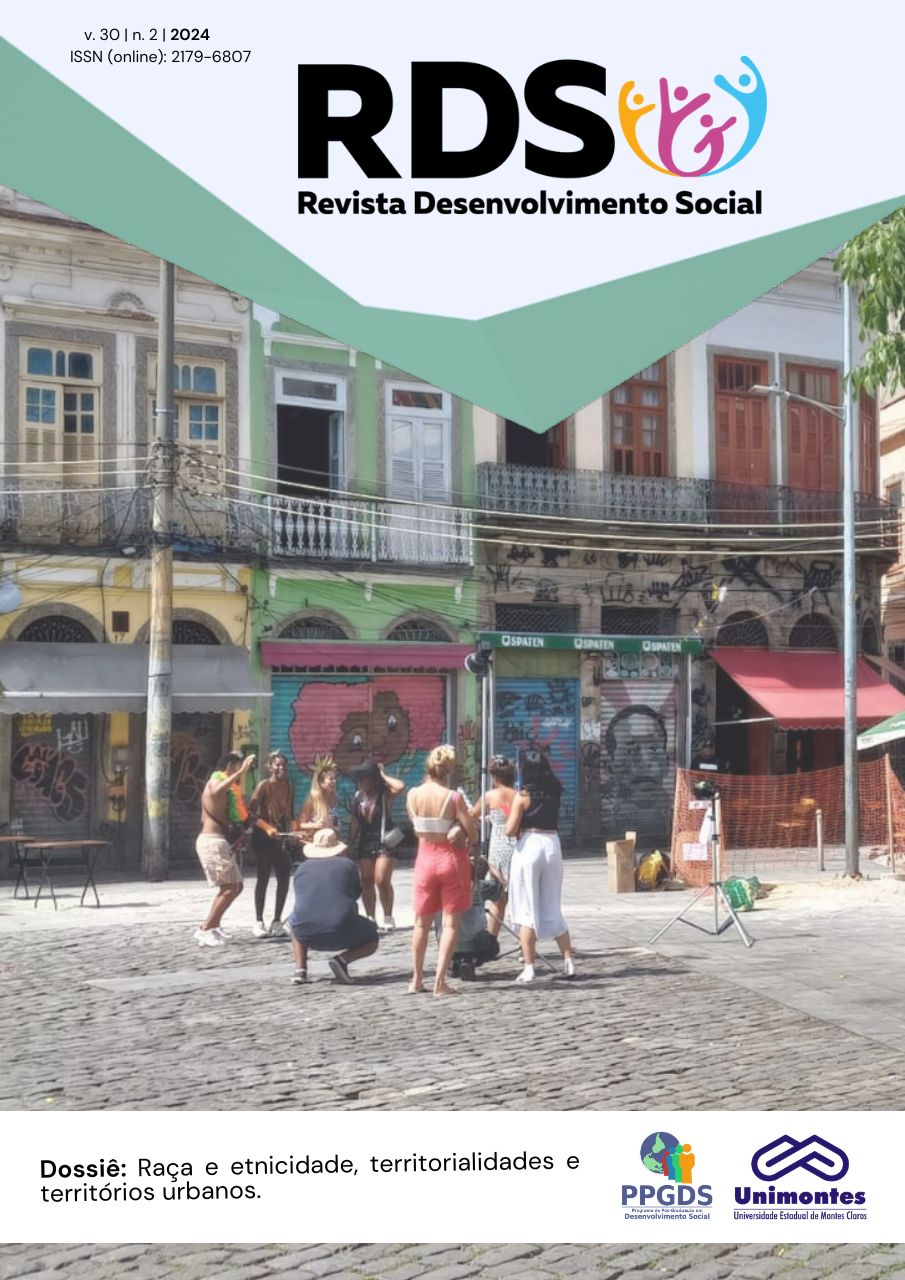TERRITÓRIOS DO AMANHÃ: O QUILOMBO DO MOLA, AMAZÔNIA, BRASIL
TOMORROW’S TERRITORY: THE QUILOMBO OF MOLA, AMAZON, BRAZIL
DOI:
https://doi.org/10.46551/issn2179-6807v30n2p92-122Keywords:
Arqueologia digital, Quilombos amazônicos, Memória colaborativa, Patrimônio cultural, Cartografia afetivaAbstract
The research proposes expanding quilombola territory into the digital environment by creating a collaborative memory archive and a virtual territory that acts as a prosthetic extension of the physical space. Practices such as electronic modeling and affective cartography support the preservation and communication of the historical and contemporary legacies of Amazonian quilombola communities, promoting cultural continuity in new spatialities. This study explores material and non-material interactions within an Amazonian quilombo, employing both archaeological and digital approaches to understand identity construction and quilombola heritage preservation. Using field observation and material analysis, we examine ceramic fragments, aluminum cans, flip-flops, and other everyday artifacts, emphasizing the importance of an archaeology of the present and future. We conclude that the overlap of temporalities and the transposition of physical elements into the virtual realm are crucial in the reinterpretation and management of cultural heritage, ensuring representativity and identity continuity in the digital context.
Downloads
References
A história do Quilombo do Mola. 31 maio 2018. Disponível em: <https://www.youtube.com/watch?v=5lw98mMXPn8>. Acesso em: 2 nov. 2024
AZUMA, R. T. A Survey of Augmented Reality. Presence: Teleoperators and Virtual Environments, v. 6, n. 4, p. 355–385, ago. 1997.
BOYD, DANAH M.; ELLISON, N. B. Social network sites: Definition, history, and scholarship. Journal of Computer-Mediated Communication, v. 13, n. 1, p. 210–230, 2007.
BRITTON, C. Edouard Glissant and postcolonial theory: strategies of language and resistance. [s.l.] Charlottesville, Va.: University Press of Virginia, 1999.
CASTELLS, M. The Rise of the Network Society. [s.l.] John Wiley & Sons, 2011.
CASTELLS, M. Communication Power. [s.l.] OUP Oxford, 2013.
CRAMPTON, J. W. Mapping: a critical introduction to cartography and GIS. [s.l.] Malden, Mass: Wiley-Blackwell, 2010.
DELEUZE, G. et al. A Thousand Plateaus: Capitalism and Schizophrenia. Journal of Interdisciplinary History, v. 19, n. 4, p. 657, 1989.
DODGE, M.; KITCHIN, R.; PERKINS, C. (EDS.). Rethinking Maps: New Frontiers in Cartographic Theory. London: Routledge, 2011.
FORTE, M. Introduction to cyber-archaeology. Em: Cyber-Archaeology, BAR International Series. [s.l: s.n.]. v. 2177p. 9–13.
FRISCHER, B.; DAKOURI-HILD, A. (EDS.). Beyond Illustration: 2D and 3D Digital Technologies as Tools for Discovery in Archaeology. Ann Arbor, MI: University of Michigan Press, 2008.
GILLINGS, M. The Real, the Virtually Real, and the Hyperreal: The Role of VR in Archaeology. Em: Envisioning the Past. [s.l.] John Wiley & Sons, Ltd, 2005. p. 223–239.
GLISSANT, É. Poética da relação. [s.l.] Bazar do Tempo, 2021.
GONZÁLEZ‐RUIBAL, A. Time to Destroy: An Archaeology of Supermodernity. Current Anthropology, v. 49, n. 2, p. 247–279, abr. 2008.
HALL, S.; GAY, P. DU. Questions of Cultural Identity: SAGE Publications. [s.l.] SAGE, 1996.
HARLEY, J. B. Deconstructing the map. Passages, 1992.
HARRISON, R. Surface assemblages. Towards an archaeology in and of the present. Archaeological Dialogues, v. 18, n. 2, p. 141–161, dez. 2011.
HARVEY, D. Spaces of Capital: Towards a Critical Geography. New York: Routledge, 2001.
JENKINS, H. Convergence Culture: Where Old and New Media Collide. [s.l.] NYU Press, 2006.
KAPELL, M. W.; ELLIOTT, A. B. R. Playing with the Past: Digital Games and the Simulation of History. [s.l.] Bloomsbury Publishing USA, 2013.
KETELAAR, F.; MCKEMMISH, S.; GILLILAND-SWETLAND, A. J. 2024 “Communities of Memory”: Pluralising Archival Research and Education Agendas.
KOLLER, D.; FRISCHER, B.; HUMPHREYS, G. Research challenges for digital archives of 3D cultural heritage models. J. Comput. Cult. Herit., v. 2, n. 3, p. 7:1-7:17, 5 jan. 2010.
LEFEBVRE, H. La production de l’espace. L’Homme et la société, v. 31, n. 1, p. 15–32, 1974.
MAFFESOLI, M. The Time of the Tribes: The Decline of Individualism in Mass Society. London: SAGE Publications Ltd, 1996.
MIGNOLO, W. D. The Darker Side of Western Modernity: Global Futures, Decolonial Options. Illustrated edição ed. Durham: Duke University Press, 2011.
Minor Transnationalism. [s.l.] Duke University Press, 2005.
NORA, P. Between Memory and History: Les Lieux de Mémoire. Representations, n. 26, p. 7–24, 1989.
PINTO, B. C. DE M. Escravidão, Fuga e a Memória de Quilombos na Região do Tocantins. Projeto História: Revista do Programa de Estudos Pós-Graduados de História, v. 22, 2001.
PINTO, B. C. DE M. História, Memória e Poder Feminino em Povoados Amazônicos. XI Encontro Nacional de História Oral. Anais.2012.
PINTO, B. C. DE M. Mulheres Negras Rurais: Resistência e Luta por Sobrevivência na Região do Tocantins (PA). XXVI Simpósio Nacional de História. Anais...2016.
REILLY, P. Towards a virtual archaeology. 1 jan. 1990.
RIVA, G.; ANOLLI, L. (EDS.). From communication to presence: cognition, emotions and culture towards the ultimate communicative experience: Festschrift in honor of Luigi Anolli. Amsterdam; Oxford: IOS Press, 2006.
SALLES, V. O negro no Pará sob o regime da escravidão. 3a edição revista e ampliada ed. Belém [Brazil]: Instituto de Artes do Pará, Programa Raízes, 2005.
SCHMALSTIEG, D.; HOLLERER, T. Augmented Reality: Principles and Practice. Illustrated edição ed. Boston: Addison-Wesley Professional, 2015.
SCHOFIELD, J. Combat archaeology: material culture and modern conflict. [s.l: s.n.].
SCHUMAHER, S.; JUNIOR, E. G. Lélia Gonzalez (1935 -1994). Memória Feminista Antirracista, 2024.
SHIELDS, R. Lefebvre, Love and Struggle: Spatial Dialectics. London: Routledge, 1998.
SMITH, P. L. T. Decolonizing Methodologies: Research and Indigenous Peoples. [s.l.] Zed Books Ltd., 2021.
Published
How to Cite
Issue
Section
Categories
License
Copyright (c) 2025 Diogo Menezes Costa

This work is licensed under a Creative Commons Attribution-NonCommercial-NoDerivatives 4.0 International License.
Esta licença permite que outros(as) façam download do trabalho e o compartilhe desde que atribuam crédito ao autor(a), mas sem que possam alterá-lo de nenhuma forma ou utilizá-lo para fins comerciais.












.png)
.png)




.png)









